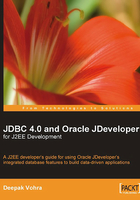
JDBC Exceptions
SQLException is the main Exception that is generated in a JDBC application. The detail of an SQL exception can be obtained from an SQLException object using the SQLException methods, some of which are discussed in following table:

When an SQLException occurs, it is likely that one or more SQLExceptions chained to it, have also occurred. The chained exceptions can be retrieved by invoking the getNextException() method recursively, until the method returns null. The cause of an SQLException can be retrieved using the getCause() method. The chained causes can be also be retrieved by invoking the getCause() method recursively, until the value, null, is returned.
If SQLException is generated output the exception message using the getMessage() method, output the exception causes using the getCause() method recursively, and retrieve exceptions chained to the exception using the getNextException() method recursively:
catch(SQLException e)
{
while(e != null)
{
System.out.println("SQLException Message:" + e.getMessage());
Throwable t = e.getCause();
while(t != null)
{
System.out.println("SQLException Cause:" + t);
t = t.getCause();
}
e = e.getNextException();
}
}
Some of the subclasses in the SQLException class are listed in following table:

JDBC 4.0 has added support for categorization of SQLExceptions and enhanced support for chained SQLExceptions, which we will discuss in a later section.